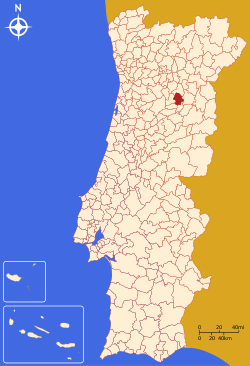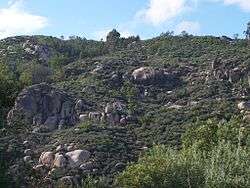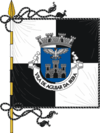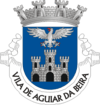Aguiar da Beira
| Aguiar da Beira | |||
|---|---|---|---|
| Municipality | |||
|
The terrain around Caldas-da-Cavaca, showing the rugged rock-outcroppings near the train terminal | |||
| |||
 | |||
| Coordinates: 40°49′03″N 7°32′36″W / 40.81750°N 7.54333°WCoordinates: 40°49′03″N 7°32′36″W / 40.81750°N 7.54333°W | |||
| Country |
| ||
| Region | Centro | ||
| Subregion | Dão-Lafões | ||
| Intermunic. comm. | Viseu Dão Lafões | ||
| District | Guarda | ||
| Parishes | 10 | ||
| Government | |||
| • President | Augusto Fernando Andrade (PPD-PSD) | ||
| Area | |||
| • Total | 206.77 km2 (79.83 sq mi) | ||
| Population (2011) | |||
| • Total | 5,473 | ||
| • Density | 26/km2 (69/sq mi) | ||
| Time zone | WET/WEST (UTC+0/+1) | ||
| Area code | 292 | ||
| Website | http://www.cm-aguiardabeira.pt | ||
Aguiar da Beira (Portuguese pronunciation: [ɐɣiˈaɾ ðɐ ˈβɐjɾɐ]) is a municipality in Guarda District in Portugal. The population in 2011 was 5,473,[1] in an area of 206.77 km².[2]
The present Mayor is Augusto Fernando Andrade, elected by the Social Democratic Party. The municipal holiday is February 10.
Parishes
Administratively, the municipality is divided into 10 civil parishes (freguesias):[3]
- Aguiar da Beira e Coruche
- Carapito
- Cortiçada
- Dornelas
- Eirado
- Forninhos
- Pena Verde
- Pinheiro
- Sequeiros e Gradiz
- Souto de Aguiar da Beira e Valverde
Population
| Número de habitantes[4] | ||||||||||||||
|---|---|---|---|---|---|---|---|---|---|---|---|---|---|---|
| 1864 | 1878 | 1890 | 1900 | 1911 | 1920 | 1930 | 1940 | 1950 | 1960 | 1970 | 1981 | 1991 | 2001 | 2011 |
| 6 909 | 7 566 | 8 053 | 8 466 | 8 919 | 8 635 | 8 545 | 9 625 | 10 177 | 10 215 | 8 464 | 7 285 | 6 725 | 6 247 | 5 473 |
| Número de habitantes por Grupo Etário [5] | ||||||||||||
|---|---|---|---|---|---|---|---|---|---|---|---|---|
| 1900 | 1911 | 1920 | 1930 | 1940 | 1950 | 1960 | 1970 | 1981 | 1991 | 2001 | 2011 | |
| 0-14 Anos | 2 771 | 3 162 | 3 063 | 3 102 | 3 471 | 3 522 | 3 430 | 2 765 | 1 912 | 1 427 | 949 | 611 |
| 15-24 Anos | 1 559 | 1 424 | 1 467 | 1 573 | 1 496 | 1 684 | 1 690 | 1 460 | 1 264 | 1 010 | 840 | 564 |
| 25-64 Anos | 3 545 | 3 718 | 3 573 | 3 619 | 3 891 | 4 145 | 4 196 | 3 510 | 2 955 | 2 892 | 2 912 | 2 659 |
| = ou > 65 Anos | 530 | 539 | 504 | 588 | 657 | 797 | 899 | 830 | 1 154 | 1 396 | 1 546 | 1 639 |
| > Id. desconh | 4 | 23 | 16 | 25 | 32 | |||||||
(Obs: De 1900 a 1950 os dados referem-se à população "de facto", ou seja, que estava presente no concelho à data em que os censos se realizaram. Daí que se registem algumas diferenças relativamente à designada população residente)
References
- ↑ Instituto Nacional de Estatística
- ↑ Direção-Geral do Território
- ↑ Diário da República. "Law nr. 11-A/2013, page 552 5" (pdf) (in Portuguese). Retrieved 15 July 2014.
- ↑ Instituto Nacional de Estatística (Recenseamentos Gerais da População) - https://www.ine.pt/xportal/xmain?xpid=INE&xpgid=ine_publicacoes
- ↑ INE - http://censos.ine.pt/xportal/xmain?xpid=CENSOS&xpgid=censos_quadros
External links
This article is issued from Wikipedia - version of the 5/31/2016. The text is available under the Creative Commons Attribution/Share Alike but additional terms may apply for the media files.


